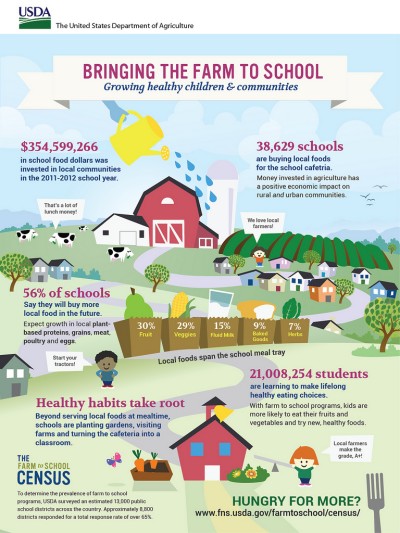Farm to School Helps Bring Local Foods to School Cafeterias
ANNAPOLIS (Nov. 4, 2013)—Maryland ranks 5th in the nation in the amount of local food served in schools with 21 percent of its school food budgets spent on Maryland-grown products according to the USDA’s recently released Farm to School Census. Maryland school districts that bought local products in the 2011-2012 school year spent an estimated $41.2 million on school food, with $8.5 million of that directed locally – and 63 percent of these districts say they will buy more local foods in the future. The Census also found that 77 percent of Maryland schools are purchasing vegetables and fruit, with the top items being: apples, peaches, tomatoes, corn and milk.
"The Farm to School Program is not only good for the well-being of school children and farmers, it’s also an investment in the health and well being of local economies. We are very excited to see Maryland among the top states in the nation leading this effort," said Agriculture Secretary Buddy Hance. "We know that when students visit a farm or tend to a garden they are more likely to make healthier food choices. And when schools invest in their local communities, all of agriculture benefits, including local farmers, ranchers, fishermen, food processors and manufacturers. I am very pleased that Maryland schools are supporting their students by supporting Maryland farms."
Maryland is one of only eight states in the nation in which more than 75 percent of its school districts are participating in farm to school activities. Ninety-one (91) percent of Maryland school districts reported that they are engaged in farm-to-school activities and another nine percent said they were planning to becoming involved in the near future, making Maryland one of the state’s most actively involved in the Farm to School movement, according to the Census. In Maryland, 22 of the state’s 25 public school districts completed the USDA Farm to School Census. These districts represent about 1,023 individual schools and 590,000 children involved in farm to school activities.
The Farm to School Program encompasses all efforts to bring locally produced foods into school cafeterias, including hands-on learning activities such as farm visits and the integration of food-related lessons, including nutrition and agricultural education into the standards-based classroom curriculum. The Maryland Department of Agriculture’s Farm to School Program in partnership with the Maryland State Department of Education work together throughout the year to link schools with local farms.
“Maryland’s Farm to School Program provides students with nourishing foods necessary for academic success, while strengthening their understanding of health, agriculture, and local economies,” said State Superintendent of Schools Lillian Lowery.
The USDA recently conducted the first nationwide census on Farm to School, covering school year 2011-2012, to determine its reach and activity level.
In addition to buying local products and building school gardens, school districts in Maryland are promoting locally produced foods at school in general (64 percent), celebrating Farm to School Month (59 percent), and holding taste tests/demos of locally produced foods (55 percent).
Nationwide, 43 percent of public school districts across the country reported having an existing farm to school program, with another 13 percent of school districts surveyed committed to launching a farm to school program in the near future. Schools participating in farm to school activities nationwide purchased and served more than $350 million in local food.
Find out how your school district responded:
www.fns.usda.gov/farmtoschool/census/#/district/md
School districts that missed the opportunity to respond can submit information regarding farm to school practices through November 30, 2013.
The Homegrown School Lunch Week, an element of the Jane Lawton Farm to School Program, was created during the 2008 Session of the Maryland General Assembly. The bill was sponsored by Senator Jamie Raskin and Delegate Sheila Hixson of Montgomery County and signed into law by Governor Martin O’Malley.
For more information about Maryland’s Farm to School program, including educational materials, menus, places to find local products, brief video soundbook with photos and interviews, plus much more for parents, teachers, and food service staff, visit:
www.marylandfarmtoschool.org. For information on the school meals programs, visit:
www.eatsmartmaryland.org. More on the benefits of buying local is available online.
For more information about the USDA Farm to School program including the Census, please visit
www.fns.usda.gov/farmtoschool.
Maryland Department of Agriculture



